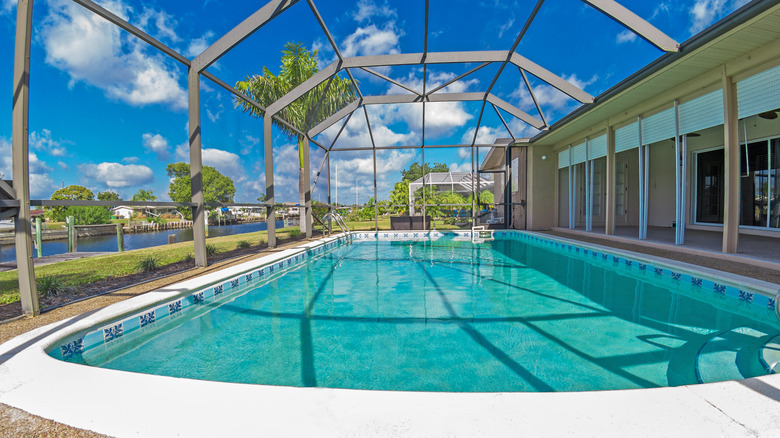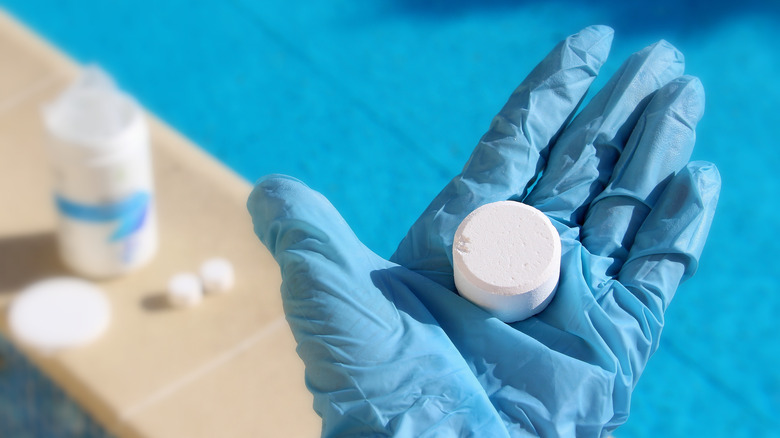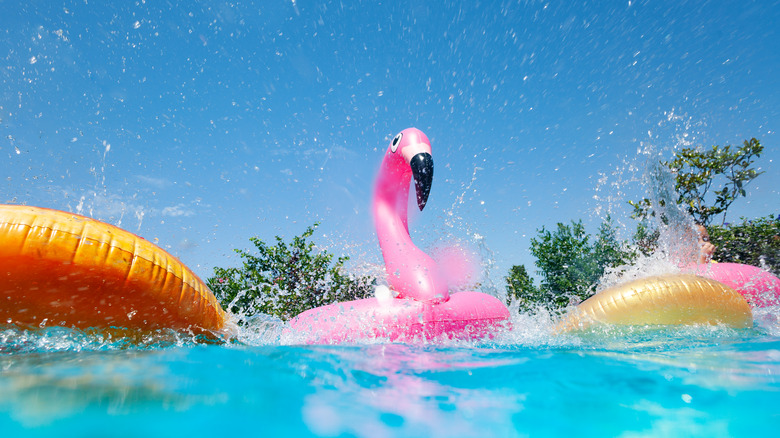What Happens If You Put Chlorine In A Saltwater Pool?
A saltwater swimming pool offers so many benefits for both your health and your wallet. "Salt water naturally draws out impurities and toxins," said Dr. Rhonda Klein, a board-certified dermatologist, to Real Simple. "The sulfur in salt water has a keratolytic effect — it softens and helps remove dead skin cells and prevent clogged pores." Besides providing glowing skin, the salt can also help alleviate anxiety, helping you de-stress. They're a total home upgrade. In general, saltwater pools are easier to maintain, too. While setting one up can require some funds, over time you save money since you won't need all that chlorine to run it (via LayorCare).
Saltwater pools have become more popular over the years, and there are now about 1.4 million of them nationwide, per Inland Press Association. In fact, 75% of new inground pool installations use salt water — a huge boost from 2002's 15%. Since there is such a divide between saltwater and chlorine pools, you might think that adding chlorine to a salt pool would ruin its benefits. But here's a secret: Chlorine is already present. The pool's salt chlorinator creates the right amount of chlorine needed to keep your water clean, according to Hayward. While there are reasons to add extra chlorine to your saltwater pool, you must do so carefully. Too much chlorine with salt water is never a good combination.
Why would you put chlorine in a saltwater pool?
Sometimes a saltwater pool's chlorinator isn't creating enough chlorine, and the water can become cloudy or develop algae. When this happens, a bit of chlorine can save the day, said Hunker. You can add extra chlorine to the pool through calcium hypochlorite, sodium hypochlorite, or chlorine tablets. Pool Care Guy pointed out that saltwater pool systems usually have a super-chlorinate option, but that won't always resolve the problem. Running the feature too often can hurt the motor, wearing it out sooner than it should.
In order to shock your pool, make sure you test your pool's pH, alkalinity, and calcium hardness levels, so you know the details of what's going on, and if there are additional problems you haven't pinpointed yet. Next, adjust any chemicals that aren't in the normal range. Pool Care Guy suggested the following guidelines: pH (7.4-7.6), alkalinity (80-140 ppm), calcium hardness (200-400).
Once the chemicals are adjusted, figure out how much shock you need. This depends on the product you've chosen. To add the shock, make sure your filtration system is turned on so it can help distribute the product. Then following the directions listed on the label, add the chlorine. Most of the time, this will require you to put it directly into the water. Once you reach the right chlorine level, you can reduce your salt chlorinator's settings. The shock will remain in the water for a few days.
What happens when you add too much chlorine?
Do not swim in a freshly shocked pool or one that is over-chlorinated, warned Own the Pool. The consequences include anything from irritated eyes and skin to death. Extra chlorine in a pool impacts humans adversely, causing lung issues, skin and eye irritations, and increasing asthma attacks, said Aquatech. So a surplus of chlorine is never something a pool owner ever wants. It turns out that you can have too much of a good thing.
Still, over-shocking a pool isn't the worst thing (as long as you don't swim in it immediately afterward), according to H2ouse. If you do nothing, the excess chlorine should dissipate within two days. Too much chlorine in the pool, though, can whiten the liner and make it brittle. This promotes leaks, and once that happens, the only fix is to replace the liner. Chlorine neutralizers may help remove a saturation of chlorine (via Flower Mound Pool Care and Maintenance). Compounds such as Sodium thiosulfate, sodium sulfite, and sodium metabisulfite all help take away the excess. But you don't need to go the chemical route; sunlight (or its UV rays) also dissipates chlorine. This route is natural, cheap, and only requires a bright, sunny day.


